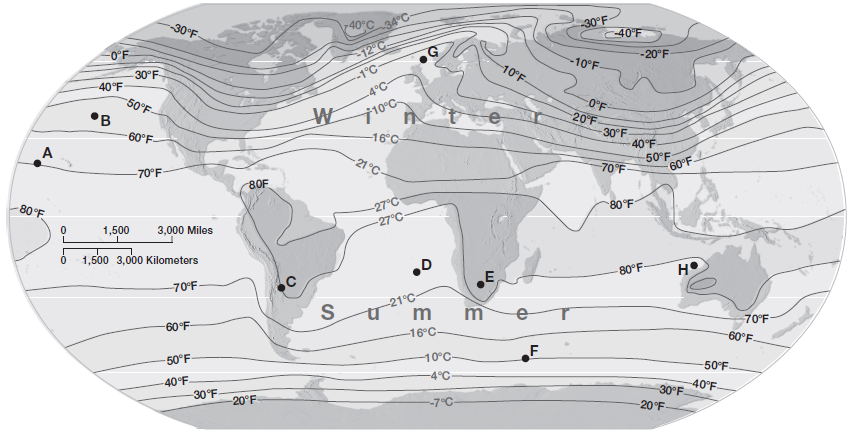Determine the average January sea-level temperature at the following eight lettered points. Indicate if your answers are in °C or °F.
The following questions are based on the isotherm map in Figure 6-3, showing average January sea-level temperatures in °C and °F. Eight lettered points (labeled “A” to “H”) are shown on the map.

Figure 6-3: Average January sea-level temperatures (°C and °F). (Adapted from McKnight and Hess, Physical Geography, 9th ed.)
A. ____ / 70° F
B. ____ / 55° F
C. ____ / 80° F
D. ____ / 72° F
E. ____ / 82° F
F. ____ / 50° F
G. ____ / 33° F
F. ____ / 78° F
A. 21° C / 70° F
B. 13° C / 55° F
C. 27° C / 80° F
D. 22° C / 72° F
E. 28° C / 82° F
F. 10° C / 50° F
G. 1° C / 33° F
F. 26° C / 78° F
You might also like to view...
While Burma was a British colony, it received a large number of migrants from
A. India B. China C. Sri Lanka D. England
Acid deposition results from
A) carbonic acids dissolved from atmospheric carbon dioxide. B) nitric acid and sulfuric acid, formed from nitrogen oxides and sulfur dioxide. C) hydrocarbons, nitrogen dioxide, and carbon monoxide. D) hydrochloric acid, formed from the combination of hydrogen chloride and water.
Changes in habitat have tremendous effects on the organisms that depend on them. These effects are ________
A) generally negative; organisms are already adapted to the habitats in which they occur and any change is likely to render the habitat less suitable B) generally negative; the changes usually cause rapid extinction of most species C) generally positive; the changes increase the habitat that is available for species to colonize D) generally neutral; the variations within each species allow them to adapt very quickly E) generally positive; organisms are already adapted to the habitats in which they occur and any change is likely to render the habitat more suitable
What type of galaxy has a mix of young and old stars, an abundant amount of gas and dust, ongoing star formation, and a definitive shapes?
A. irregular galaxies B. elliptical galaxies C. spiral galaxies D. All types of galaxies share these features.